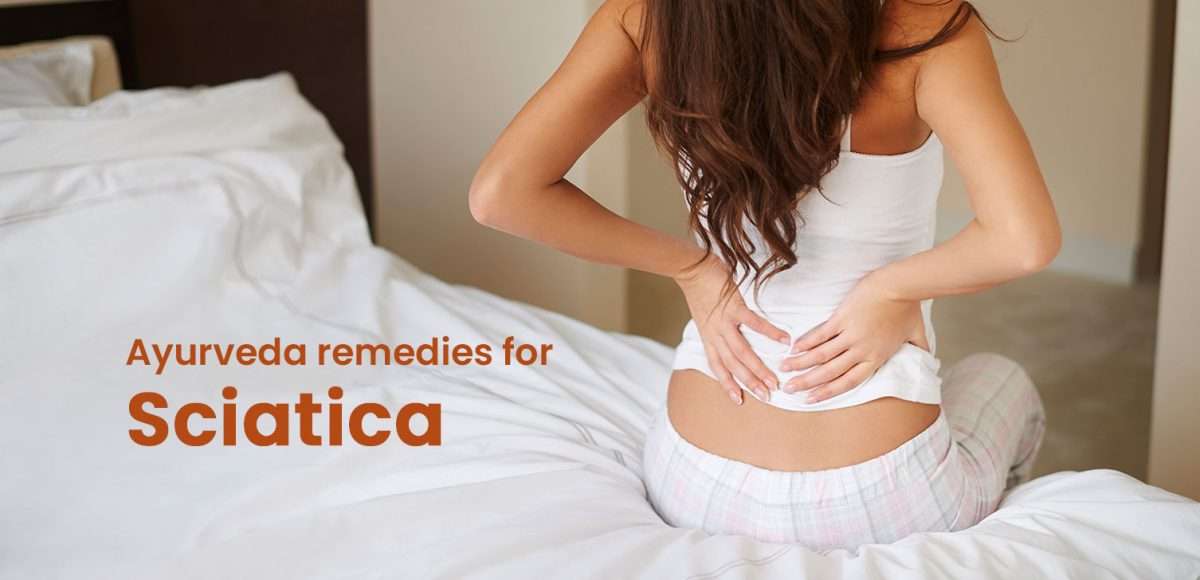Ayurvedic Management of Sciatica

Low back pain is one of the common health conditions experienced by people once in their lifetime. Sciatica is one of the conditions causing chronic low back pain. Nearly 40% of individuals experience sciatic pain once in their lifetime.
The working population is significantly at risk from sciatica. The patient’s daily routine and overall quality of life is disrupted due to persistent, stretching pain. Only conservative treatment gives short-term relief from pain or surgical intervention with side-effect. Since pain impacts a patient’s physical, emotional, and social lives today, there is a need to find quick relief from it. Ayurveda provides sciatic pain relief without the need for surgery.
What is Sciatica?
Any irritation or compression to the sciatic nerve leads to sciatica. Sciatica is characterized by lower back pain radiating to either one or both legs along the length of the sciatic nerve.
In more than 90% of situations, a herniated disc with nerve root compression is the cause of sciatica. The other causes are spinal nerve stenosis, spondylolisthesis, tumor in the spine, cauda equina syndrome, and injuries such as pelvic fractures.
Symptoms of Sciatica
The individual affected with sciatica experiences:
- Low back ache radiating along the posterior aspect of the thigh towards the feet.
- Numbness, tingling sensation, or weakness in the affected region.
- Difficulty in raising the leg.
- The symptoms usually affect unilaterally.
- Sitting, attempting to stand up, leaning forwards, twisting the spine, lying down, and coughing may make sciatica symptoms worse.
Sciatica- Correlation in Ayurveda
As per symptomatology, Sciatica can be correlated with the disease Gridhrasi in Ayurveda. The sciatic nerve (gridharsi nadi) is impacted by the vitiated vata dosha, which results in low back pain that extends to the lower limbs, stiffness, and pricking-type pain. The pain radiates down the back of the leg through the posterior part of the pelvic and lumbosacral regions, eventually reaching the tips of the feet.
The patient experiences recurring throbs along the affected leg coupled with the classic Gridhrasi pain, which is accompanied by stambha (rigidity), ruk (pain), and tod (pricking pain).
The condition is called “Gridhrasi” because the patient who has it walks like a vulture (Grudhra) as a result of their terrible, persistent, and migrating discomfort.
How to manage Sciatica in Ayurveda
Ayurvedic management of Sciatica pain is very effective and should be performed by qualified practitioners after prior consultation. By using a variety of process from diet to ayurvedic massage, we aim to implement the best treatments for our patients to lessen their discomfort. Since Sciatica is a Vata vyadhi, the treatment procedures are based on the management of Vata dosha. The aim of treatment is to bring the aggravated vata back to equilibrium and thereby restore the state of health.
This can be achieved by certain ayurvedic massage therapy which involves:
Panchakarma: It is the first line of Ayurvedic Treatment, which focuses on the complete treatment of the disease. The treatment protocols in panchakarma therapies are determined based on the condition of the patient and involves the following principles like:
- Oleation therapy: The affected individual is treated with ghee, oil, etc both internally and externally.
- Fomentation therapy: Various fomentation therapies like tub bath, nadi swedam, choorna pinda sweda, dhanyamla dhara, patra pinda swedam, Kashaya dhara, etc can be administered to the individual.
- Medicated enema: In Ayurveda, medicated enema is considered the best treatment for the treatment of vata dosha. Both niruha and anuvasana types of enema can be administered
- Medicated purgation: Mild purgation with drugs that are unctuous in nature can be administered.
- Kati Vasti: Kati Vasti involves specially prepared warm herbal being poured and retained inside a flour dough boundary kept in the lower back for a specified duration time.
- Venesection (Sira vedana) or bloodletting: Bloodletting must be performed 3 inches above or below the knee joint.
- Cauterisation: Cauterisation must be done in areas with severe pain to reduce nerve irritation.
Yoga is also advised for persons suffering from Sciatica. By getting professional advice from our practitioners, patients are advised to follow gentle yoga postures which allow the sciatic nerves to stay mobile and reduce the inflammation naturally.
Along with the external therapeutic procedures, the intake of ayurvedic medicinal supplements is also necessary for the proper management of the disease.
Care to be taken:
- Do exercise regularly to strengthen the low back region.
- Keep good posture while sitting.
- For better support use a pillow or rolled towel in the back.
- Keep the knee joint and hip joint at the proper level while sitting.
- Use hot or cold packs for comfort.
- Practice yoga and mild stretching exercise.
Conclusion
Ayurclinic focuses on precision classical Ayurveda treatment protocols, following the fundamental principles of Ayurveda in addressing the root cause of diseases. After an in-depth assessment of the symptoms, detailed history and understanding the patient and the disease thoroughly, a definite treatment protocol is designed by our Ayurveda doctors Melbourne.
If you are looking for an ayurvedic treatment for sciatica pain that will improve your quality of life in long run, look no further. Using Ayurveda therapies, gentle movements and dietary plans, we design treatments for your exact needs.
To schedule an ayurvedic consultation, get in touch with us today!







